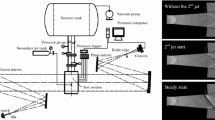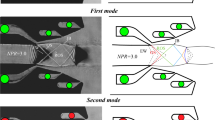Abstract
The passive fluidic thrust vectoring technology is highly applicable in the next-generation high-maneuverability and high-stealth aircraft. Jet deflection control plays an important role in passive fluidic thrust vectoring control. In this research, we developed a passive fluidic thrust vectoring nozzle, which can control the primary jet to deflect between the attached state and detached state by controlling the passive secondary flow. Based on this model, the transient process of unsteady near-wall flow structures evolution during jet deflection as well as the mechanism of jet deflection control are investigated. Particle image velocimetry measurement is applied to obtain time-averaged flow topological structures of the jet in two steady states. High frame rate smoke visualization is applied to investigate the transient characteristics of the near-wall unsteady flow structures such as shear layer vortices, secondary flow, and trailing edge backflow. The results show that in the near-wall region, the entrainment of the shear layer fights against the replenishment of the secondary flow and the backflow. Thus, the mass flux of the near-wall region is in dynamic balance, which means the total amount of fluid in this region is invariant. Shutting off or opening the secondary flow is the trigger for the collapse or reestablishment of this mass flux balance. The vanishing or reappearance of the backflow is the dominant cause of jet deflection.
Graphical abstract














Similar content being viewed by others
Abbreviations
- x, y, z :
-
Axis of coordinates
- H :
-
Height of the wind tunnel exit
- W :
-
Width of the wind tunnel exit
- L :
-
Length of the inclined wall
- θ :
-
Inclination angle of the wall
- G :
-
Offset of the secondary flow channel
- v ∞ :
-
Velocity of the jet at the wind tunnel exit
- t, t * :
-
Time and nondimensional time, t* = tv∞/L
- Re:
-
Reynolds number based on H, Re = v∞H/μ
- μ :
-
Kinematic viscosity of air
- FTVC:
-
Fluidic thrust vectoring control
- K-H instability:
-
Kelvin–Helmholtz instability
- MTVC:
-
Mechanical thrust vectoring control
- PIV:
-
Particle image velocimetry
- V0, V1, V2:
-
Vortex 0, Vortex 1, Vortex 2 (of the shear layer)
References
Bau HH (1982) Kelvin-Helmholtz instability for parallel flow in porous media: a linear theory. Phys Fluids 25(10):1719–1722. https://doi.org/10.1063/1.863642
Bourque C, Newman BG (1960) Reattachment of a two-dimensional, incompressible jet to an adjacent flat plate. Aeronaut Quarterly 11(3):201–232. https://doi.org/10.1017/s0001925900001797
Broadwell JE, Breidenthal RE (1982) A simple model of mixing and chemical reaction in a turbulent shear layer. J Fluid Mech 125:397–410. https://doi.org/10.1017/S0022112082003401
Flamm JD (1998) Experimental study of a nozzle using fluidic counterflow for thrust vectoring. AIAA. https://doi.org/10.2514/6.1998-3255
Gong DS, Gu YS, Zhou YH, Shi NX (2020) Control law of passive fluid thrust vector nozzle based on thermal jet of micro turbojet engine. Acta Aeronaut Astronaut Sin 41(10):123609. https://doi.org/10.7527/S1000-6893.2019.23609
Levin SG, Manion FM (1962) Jet Attachment Distance as a Function of Adjacent Wall Offset and Angle. HDL-TR-1087
Lian YJ (2008) Fluidic thrust vectoring techniques research. Aircr Des 28(2):19–24. https://doi.org/10.3969/j.issn.1673-4599.2008.02.005
Lund TS (1986) Augmented thrust and mass flow associated with two-dimensional jet reattachment. AIAA J 24(12):1964–1970. https://doi.org/10.2514/3.9554
Maruyama Y, Sakata M, Takahashi Y (2021) Performance analyses of fluidic thrust vector control system using dual throat nozzle. AIAA J 10(2514/1):J059696
Nasr A, Lai JCS (2000) The effects of wall inclination on an inclined offset jet. In: 10th International symposium applications of laser techniques to fluid mechanics
Nasr A, Lai JCS, Siah O, Young J (2006) Flow characteristics of an inclined offset jet. In: 36th AIAA fluid dynamics conference and exhibit. https://doi.org/10.2514/6.2006-3372
Nasr A, Lai JCS (1998) A turbulent plane offset jet with small offset ratio. Exp Fluids 24(1):47–57. https://doi.org/10.1007/s003480050149
Nozaki T, Hatta K, Nakashima M (1979) Reattachment flow issuing from a finite width nozzle. Bull JSME 22(165):340–347. https://doi.org/10.1299/jsme1958.22.340
Pramanik S, Das MK (2013) Numerical characterization of a planar turbulent offset jet over an oblique wall. Comput Fluids 77:36–55. https://doi.org/10.1016/j.compfluid.2013.02.007
Sawyer RA (1960) The flow due to a two-dimensional jet issuing parallel to a flat plate. J Fluid Mech 9(4):543–559. https://doi.org/10.1017/S0022112060001304
Sawyer RA (1963) Two-dimensional reattaching jet flows including the effects of curvature on entrainment. J Fluid Mech 17(4):481–498. https://doi.org/10.1017/S0022112063001464
Shi JW, Wang ZX, Zhou L, Zhang XB (2019) Numerical investigation on a new concept of shock vector control nozzle. J Eng Gas Turb Power 141(9):091004. https://doi.org/10.1115/1.4043611
Song HB, Yoon SH, Lee DH (2000) Flow and heat transfer characteristics of a two-dimensional oblique wall attaching offset jet. Int J Heat Mass Transf 43(13):2395–2404. https://doi.org/10.1016/S0017-9310(99)00312-9
Song MJ, Park SH, Lee Y (2014) Application of backstep Coanda flap for supersonic coflowing fluidic thrust-vector control. AIAA J 52(10):2355–2359. https://doi.org/10.2514/1.J052971
Strykowski PJ, Krothapalli A, Wishart D (1992) The enhancement of mixing in high-speed heated jets using a counter-flowing nozzle. AIAA. https://doi.org/10.2514/6.1992-3262
Wang YS, Xu JL, Huang S, Lin YC, Jiang JJ (2019) Computational study of axisymmetric divergent bypass dual throat nozzle. Aerosp Sci Technol 86(3):177–190. https://doi.org/10.1016/j.ast.2018.11.059
Wang YS, Xu JL, Huang S, Lin YC, Jiang JJ (2020a) Experimental and numerical investigation of an axisymmetric divergent dual throat nozzle. Proc Inst Mech Eng Part G J Aerosp Eng 234(3):563–572. https://doi.org/10.1177/0954410019872089
Wang YS, Xu JL, Huang S, Jiang JJ, Pan RF (2020b) Design and preliminary analysis of the variable axisymmetric divergent bypass dual throat nozzle. J Fluids Eng 142(6):061204. https://doi.org/10.1115/1.4045996
Wing DJ (1994) Static investigation of two fluidic thrust-vectoring concepts on a two-dimensional convergent-divergent nozzle. NASA TM-4574
Wu KX, Kim HD, Jin Y (2018) Fluidic thrust vector control based on counter-flow concept. Proc Inst Mech Eng Part G J Aerosp Eng 233(4):1412–1422. https://doi.org/10.1177/0954410017752580
Wu KX, Kim TH, Kim HD (2021) Numerical study of fluidic thrust vector control using dual throat nozzle. J Appl Fluid Mech 14(1):73–87. https://doi.org/10.47176/jafm.14.01.31690
Wu KX, Kim TH, Kim HD (2021b) Sensitivity analysis of counterflow thrust vector control with a three-dimensional rectangular nozzle. J Aerosp Eng 34(1):04020107. https://doi.org/10.1061/(ASCE)AS.1943-5525.0001228
Xiao ZY, Gu YS, Jiang X, Chen ZB (2012) A new fluidic thrust vectoring technique based on ejecting mixing effects. Acta Aeronaut Astronaut Sin 33(11):1967–1974
Acknowledgements
The work was supported by the National Natural Science Foundation of China under grant number 11972017, and the National Numerical Windtunnel Project. The authors wish to thank Junjie Wen, Liangxiu Wang, and Tingting Wu for their technical guidance and support in this research.
Author information
Authors and Affiliations
Corresponding author
Additional information
Publisher's Note
Springer Nature remains neutral with regard to jurisdictional claims in published maps and institutional affiliations.
Rights and permissions
About this article
Cite this article
Shi, N., Gu, Y., Zhou, Y. et al. Experimental investigation on the transient process of jet deflection controlled by passive secondary flow. J Vis 25, 967–981 (2022). https://doi.org/10.1007/s12650-022-00841-y
Received:
Revised:
Accepted:
Published:
Issue Date:
DOI: https://doi.org/10.1007/s12650-022-00841-y




